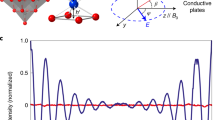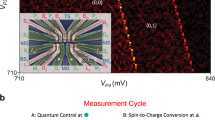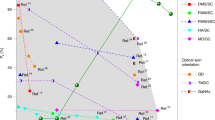Abstract
Transporting ensembles of electrons over long distances without losing their spin polarization is an important benchmark for spintronic devices. It usually requires injecting and probing spin-polarized electrons in conduction channels using ferromagnetic contacts1,2 or optical excitation3,4,5. In parallel with this development, important efforts have been dedicated to achieving control of nanocircuits at the single-electron level. The detection and coherent manipulation of the spin of a single electron trapped in a quantum dot are now well established6,7,8. Combined with the recently demonstrated control of the displacement of individual electrons between two distant quantum dots9,10, these achievements allow the possibility of realizing spintronic protocols at the single-electron level. Here, we demonstrate that spin information carried by one or two electrons can be transferred between two quantum dots separated by a distance of 4 μm with a classical fidelity of 65%. We show that at present it is limited by spin flips occurring during the transfer procedure before and after electron displacement. Being able to encode and control information in the spin degree of freedom of a single electron while it is being transferred over distances of a few micrometres on nanosecond timescales will pave the way towards ‘quantum spintronics’ devices, which could be used to implement large-scale spin-based quantum information processing.
This is a preview of subscription content, access via your institution
Access options
Subscribe to this journal
Receive 12 print issues and online access
$259.00 per year
only $21.58 per issue
Buy this article
- Purchase on Springer Link
- Instant access to full article PDF
Prices may be subject to local taxes which are calculated during checkout



Similar content being viewed by others
References
Dlubak, B. et al. Highly efficient spin transport in epitaxial graphene on SiC. Nature Phys. 8, 557–561 (2012).
Lou, X. et al. Electrical detection of spin transport in lateral ferromagnet-semiconductor devices. Nature Phys. 3, 197–202 (2007).
Kato, Y., Myers, R., Gossard, A. & Awschalom, D. Coherent spin manipulation without magnetic fields in strained semiconductors. Nature 427, 50–53 (2004).
Stotz, J. A. H., Hey, R., Santos, P. V. & Ploog, K. H. Coherent spin transport through dynamic quantum dots. Nature Mater. 4, 585–588 (2005).
Sanada, H. et al. Manipulation of mobile spin coherence using magnetic-field-free electron spin resonance. Nature Phys. 9, 280–283 (2013).
Hanson, R., Petta, J. R., Tarucha, S. & Vandersypen, L. M. K. Spins in few-electron quantum dots. Rev. Mod. Phys. 79, 1217–1265 (2007).
Shulman, M. D. et al. Demonstration of entanglement of electrostatically coupled singlet–triplet qubits. Science 336, 202–205 (2012).
Veldhorst, M. et al. An addressable quantum dot qubit with fault-tolerant control-fidelity. Nature Nanotech. 9, 981–985 (2014).
Hermelin, S. et al. Electrons surfing on a sound wave as a platform for quantum optics with flying electrons. Nature 477, 435–438 (2011).
McNeil, R. et al. On-demand single-electron transfer between distant quantum dots. Nature 477, 439–442 (2011).
Thalineau, R. et al. A few-electron quadruple quantum dot in a closed loop. Appl. Phys. Lett. 101, 103102 (2012).
Petta, J. R. et al. Coherent manipulation of coupled electron spins in semiconductor quantum dots. Science 209, 2180–2184 (2005).
Medford, J. et al. Quantum-dot-based resonant exchange qubit. Phys. Rev. Lett. 111, 050501 (2013).
Sanchez, R. et al. Long-range spin transfer in triple quantum dots. Phys. Rev. Lett. 112, 176803 (2014).
Baart, T. A. et al. Single-spin CCD. Nature Nanotech. 11, 330–334 (2016).
Bertrand, B. et al. Quantum manipulation of two-electron spin states in isolated double quantum dots. Phys. Rev. Lett. 115, 096801 (2015).
Meunier, T. et al. High fidelity measurement of singlet–triplet state in a quantum dot. Phys. Status Solidi B 243, 3855–3858 (2006).
Elzerman, J. M. et al. Single-shot read-out of an individual electron spin in a quantum dot. Nature 430, 431–435 (2004).
Amasha, S. et al. Electrical control of spin relaxation in a quantum dot. Phys. Rev. Lett. 100, 046803 (2008).
Meunier, T. et al. Experimental signature of phonon-mediated spin relaxation in a two-electron quantum dot. Phys. Rev. Lett. 98, 126601 (2007).
Zutic, I., Fabian, J. & Das Sarma, S. Spintronics: fundamentals and applications. Rev. Mod. Phys. 76, 323–410 (2004).
Dugaev, V. K., Sherman, E. Y., Ivanov, V. I. & Barnas, J. Spin relaxation and combined resonance in two-dimensional electron systems with spin–orbit disorder. Phys. Rev. B 80, 081301 (2009).
Huang, P. & Hu, X. Spin qubit relaxation in a moving quantum dot. Phys. Rev. B 88, 075301 (2013).
Meier, L. et al. Measurement of Rashba and Dresselhaus spin–orbit magnetic fields. Nature Phys. 3, 650–654 (2007).
Stepanenko, D., Rudner, M., Halperin, B. I. & Loss, D. Singlet–triplet splitting in double quantum dots due to spin–orbit and hyperfine interactions. Phys. Rev. B 85, 075416 (2012).
Bertrand, B. et al. Injection of a single electron from static to moving quantum dots. Nanotechnology 27, 214001 (2016).
Acknowledgements
The authors acknowledge technical support from the technological centres of the Institut Néel. S.Tak. acknowledges financial support from Marie Sklodowska-Curie grant agreement no. 654603. M.Y. and S.Tar. acknowledge financial support from JSPS (grant nos. 26247050, 25610070 and 26220710). S.Tar. acknowledges financial support from MEXT KAKENHI ‘Quantum Cybernetics’, MEXT project for Developing Innovation Systems, and the JST Strategic International Cooperative. A.L. and A.D.W. acknowledge support from BMBF Q.com-H 16KIS0109, Mercur Pr-2013-0001 and DFH/UFA CDFA-05-06. B.B. and T.M. acknowledge financial support from ERC ‘QSPINMOTION’ and the Fondation Nanosciences.
Author information
Authors and Affiliations
Contributions
B.B. performed the experiments. B.B. and T.M. interpreted the data. B.B., C.B. and T.M. wrote the manuscript. S.Tak. designed and fabricated the sample with M.Y. and S.Tar. S.H. contributed to the experimental set-up. A.L. and A.D.W. provided the high-mobility heterostructures. All authors discussed the results and contributed to writing the manuscript.
Corresponding author
Ethics declarations
Competing interests
The authors declare no competing financial interests.
Supplementary information
Supplementary information
Supplementary information (PDF 1494 kb)
Rights and permissions
About this article
Cite this article
Bertrand, B., Hermelin, S., Takada, S. et al. Fast spin information transfer between distant quantum dots using individual electrons. Nature Nanotech 11, 672–676 (2016). https://doi.org/10.1038/nnano.2016.82
Received:
Accepted:
Published:
Issue Date:
DOI: https://doi.org/10.1038/nnano.2016.82
This article is cited by
-
Noisy intermediate-scale quantum computers
Frontiers of Physics (2023)
-
Flying electron spin control gates
Nature Communications (2022)
-
Conveyor-mode single-electron shuttling in Si/SiGe for a scalable quantum computing architecture
npj Quantum Information (2022)
-
A shuttling-based two-qubit logic gate for linking distant silicon quantum processors
Nature Communications (2022)
-
Coherent spin qubit transport in silicon
Nature Communications (2021)



